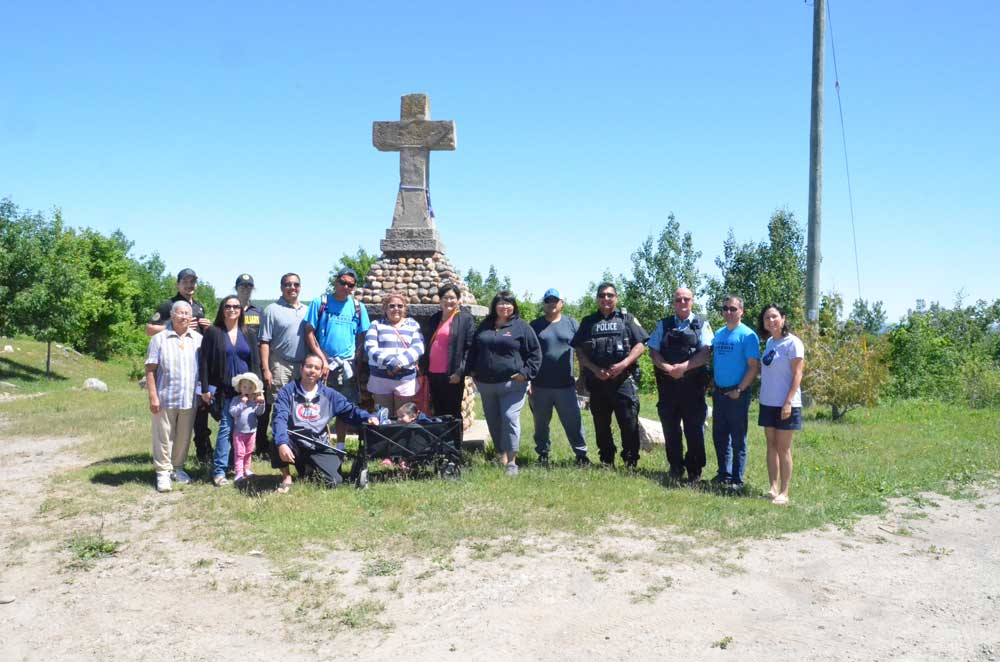WIIKWEMKOONG—So far, Anishinabe police officer Kevin Redsky has worn out three pairs of shoes on his ‘Hope in the Darkness National Walk for Youth Mental Health’ walk and he expects to go through several more before he meets up with his counterpart travelling from British Columbia. The walkers will meet in Winnipeg. Mr. Redsky agreed to take a short detour down Highway 6 to Wiikwemkoong for that community’s June 21 Aboriginal Day celebrations.
The officer was escorted into the village and down to Thunderbird Park by his colleagues from the Wikwemikong Tribal Police Service and was accompanied by community members who met him at the top of the Monument Hill leading to the community.
“I felt it was important to spend some time in an Anishinaabe community today,” said Mr. Redsky, who originally hails from Shoal Lake 40 First Nation. The ongoing tragedy of suicides in First Nation communities is one of the key elements that encouraged the 15-year police veteran to set up the Hope in the Darkness National Walk for Youth Mental Health. “It’s a not-for-profit initiative that aims to partner police officers with Indigenous youth to walk together across Canada and learn from each other’s experiences with mental health crises,” he explains. In naming the initiative, Mr. Redsky found his inspiration in lyrics from the Mumford and Sons song ‘Ghosts That We Knew.’ In fact, the Darkness National Walk for Youth Mental Health team recently partnered with the band and has made that song an official anthem for the walk.
Mr. Redsky left Newfoundland’s Cape Spear on April 1. He explained that he chose that location to start his trip as too often Canada’s actual easternmost point loses out to mainland locations.
The other team of police officers are departing from Masset, British Columbia, spending a few days on the notorious Highway of Tears, along which so many Indigenous women have disappeared or been found murdered.
The two groups are self-funding the walk but are gratefully accepting donations from sponsors and through a crowd funding campaign. Unfortunately, the decision to use that site as the venue predated a boycott that came about due to the site being utilized to fund the defence in the Colten Boushie trail. For those not wishing to go the GoFundMe route, direct donations can be made by electronic mail transfer to walkforyouthmentalhealth@gmail.com.
While the police officers are walking across the country, the real goal is aimed at getting people talking and removing the stigma surrounding mental health.
“We have been holding talking circles at as many First Nations communities as possible,” said Mr. Redsky. “We are gathering input on mental health programs as well as feedback on improving relationships between Indigenous peoples and police.”
If everything falls into place according to plan, both teams will arrive in Winnipeg in August, where there will be a concert to celebrate the conclusion of the trip and to share what has been learned with the Indigenous-led mental health network, Strength in Continuous Change.
“We want to get people talking,” said Mr. Redsky. His own personal experiences and those of his family have highlighted the importance of holding discussions on the issues of mental health, “because what’s in existence right now to treat mental health is not working.”
He pointed out that gaps in child welfare systems across Canada can make mental health problems worse and the reverse is also true.
“I hope that gathering the stories of affected youth and their families will bring some reality to how mental health care is provided in Indigenous communities,” he said. He also said that he hopes that the efforts of himself and his colleagues will help change the perception of police in First Nations communities.
“We’ve heard that police need to engage more, need to be in the school more,” said Mr. Redsky. “Right now, when youth see the police show up, they automatically think someone’s in trouble or they’re going to be apprehended. We want them to feel comfortable sharing with us their needs and once we get those conversations rolling, we’ll be on the same page and that’s the goal.”
Talking is one thing, but listening is really the key element needed in the approach to dealing with mental health issues, he added. “We all have to be ready and willing to listen without judgement.”




